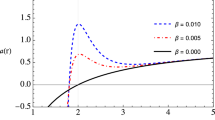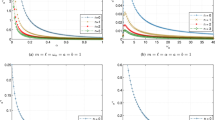Abstract
On the basis of the formulated and proven similarity properties of cosmological models based on a statistical system of degenerate scalarly charged fermions, as well as the previously identified mechanism of scalar-gravitational instability of cosmological models, a numerical and analytical study of the formation of supermassive black hole nuclei in the early Universe is carried out. A mathematical model of the evolution of spherical perturbations is constructed, making itt possible to reveal the main regularities of the process of evolution of collapsing masses and the dependence of the parameters of forming black holes on the fundamental parameters of the cosmological model and the wavelength of gravitational perturbations. In this case, the mass loss of the black hole due to quantum evaporation is taken into account. A stable tendency for the early formation of supermassive black hole nuclei in the class of cosmological models under study is shown, and a close connection between the growth of masses of spherical perturbations and the nature of the singular points of these models is shown.


















Similar content being viewed by others
Notes
When the age of the Universe is less than one billion years, \(z\gtrsim 6\).
Seeds of Supermassive Black Holes = SSBH.
Having a number of unique features (see [18]).
In [20] it is shown how this theory is obtained from microscopic dynamics.
Here and below, Latin letters run over \(\overline{1,4}\), Greek ones over \(\overline{1,3}\).
Which is fully confirmed by numerical integration.
A weak amplitude attenuation occurs only due to the geometric factor \(a(t)\).
This example is taken from [12], the plots are slightly reformatted.
Figure from the author’s paper [13].
References
S. Gillessen, F. Eisenhauer, S. Trippe, T. Alexander, R. Genzel, F. Martins, and T. Ott, Astrophys. J. 692, 1075 (2009); arXiv: 0810.4674.
Sheperd Doeleman, Jonathan Weintroub, Alan E.E. Rogers et al., Nature 455, 78 (2008); arXiv: 0809.2442.
B. Trakhtenbrot, Proc. Int. Astron. Union, 15 (S356), 261 (2019); arXiv: 2002.00972v2.
Q. Zhu, Yu. Li, Yi. Li, M. Maji, H. Yajima, R. Schneider, and L. Hernquist, Mon. Not. R. Astron. Soc. 514 (4), 5583 (2022); arXiv: 2012.01458.
L. Arturo Urena-Lopez and Andrew R. Liddle, Phys. Rev. D 66, 083005 (2002); arXiv: astro-ph/0207493.
Pedro V. P. Cunha, Carlos A. R. Herdeiro, Eugen Radu, and Helgi F. Rúnarsson, Int. J. Mod. Phys. D 25, 1641021 (2016).
Philippe Brax, Jose A. R. Cembranos, and Patrick Valageas, Phys. Rev. D 101, 023521 (2020); arXiv: 1909.02614.
E. M. Lifshitz and I. M. Khalatnikov, Sov. Phys. Usp. 6, 495 (1964).
L. D. Landau and E. M. Lifshitz, The Classical Theory of Fields (Pergamon Press, Oxford–New York–Toronto–Sydney–Paris–Frankfurt, 1971).
Yu. G. Ignat’ev, Grav. Cosmol. 27:1, 30 (2021); arXiv: 2103.13866 [gr-qc].
Yu. G. Ignat’ev, Grav. Cosmol. 27, 36 (2021); arXiv: 2103.13867.
Yu. G. Ignat’ev, Grav. Cosmol. 28, 25 (2022); arXiv: 2203.11948.
Yu. G. Ignat’ev, Grav. Cosmol. 28, 275 (2022); arXiv: 2207.05066.
Yu. G. Ignat’ev, Grav. Cosmol. 28, 375 (2022); arXiv: 2211.14507.
Yu. G. Ignat’ev, Grav. Cosmol. 28, 163 (2023); arXiv: 2305.15456.
Yu. G. Ignat’ev, Russ. Phys. J. 65, 1490 (2023); arXiv: 2302.03666.
Yu. G. Ignat’ev, Russ. Phys. J. 65, 1503 (2023); arXiv: 2302.10220.
Yu. G. Ignat’ev, Grav. Cosmol. 29, 213 (2023); arXiv: 2307.13767.
Yu. G. Ignat’ev, Theor. Math. Phys. 215, 862 (2023); arXiv: 2306.17185.
Yu. G. Ignat’ev and D. Yu. Ignat’ev, Theor. Math. Phys. 209, 1437 (2021); arXiv: 2111.00492.
Yu. G. Ignat’ev, A. A. Agathonov, and D. Yu. Ignatyev, Grav. Cosmol., 27, 338 (2021); arXiv: 2203.11946.
Yu. G. Ignat’ev and D. Yu. Ignatyev, Grav. Cosmol. 26, 29 (2020); arXiv: 2005.14010.
Yu. G. Ignat’ev, arXiv: 2307.13761.
Yu. G. Ignat’ev and I. A. Kokh, Theor. Math. Phys. 207, 514 (2021).
Ya. B. Zeldovich and I. D. Novikov, Structure and Evolution of the Universe (Nauka, Moscow, 1975) (in Russian).
Yu. G. Ignat’ev and N. Elmakhi, Russ. Phys. J. 51, 74 (2008); arXiv: 1101.1414.
Yu. G. Ignatev and A. A. Popov, Actroph. Space Sci. 163, 153 (1990); arXiv: 1101.4303.
Yu. G. Ignat’ev and A. A. Popov, Phys. Lett. A. 220, 229 (1996); arXiv: gr-qc/9604028.
Yu. G. Ignat’ev and N. Elmakhi, Russ. Phys. J. 51, 735 (2008); arXiv: 1101.1544.
Yu. G. Ignat’ev and N. Elmakhi, Russ. Phys. J. 52, 15 (2009); arXiv: 1101.1558.
Robert M. Wald, General Relativity (University of Chicago Press, Chicago, 1984).
B. S. DeWitt, Phys. Rep. C 19, 25 (1975).
Y. G. Ignat’ev, Theor. Math. Phys. 204, 927 (2020); arXiv: 2004.14865.
Yu. G. Ignat’ev, Grav. Cosmol. 25, 354 (2019); arXiv: 1908.03488.
ACKNOWLEDGMENTS
The author is grateful to the participants of the seminar of the Department of Theory of Relativity and Gravitation of Kazan University for a useful discussion of some aspects of this work. The author is especially grateful to Profs. S.V. Sushkov and A.B. Balakin for very useful comments and a discussion of the features of modern modifications of the theory of gravity as applied to cosmology and astrophysics. The author is also grateful to the participants of the 5th International Winter School-Seminar “Petrov Readings-2022” for fruitful discussions of a number of issues raised in the article, and especially to Profs. K.A. Bronnikov, M.O. Katanaev, and B. Saha.
Funding
The work was carried out at the expense of a subsidy allocated as part of the state support of the Kazan (Volga Region) Federal University in order to increase its competitiveness among the world’s leading scientific and educational centers.
Author information
Authors and Affiliations
Corresponding author
Ethics declarations
The author declares that he has no conflicts of interest.
Rights and permissions
About this article
Cite this article
Ignat’ev, Y.G. Formation of Supermassive Nuclei of Black Holes in the Early Universe by the Mechanism of Scalar-Gravitational Instability. I. Local Picture\({}^{1}\). Gravit. Cosmol. 29, 327–344 (2023). https://doi.org/10.1134/S0202289323040102
Received:
Revised:
Accepted:
Published:
Issue Date:
DOI: https://doi.org/10.1134/S0202289323040102




